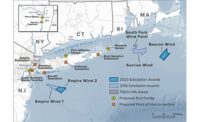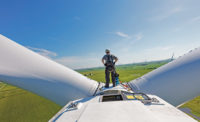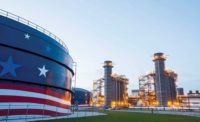For MidAmerican Energy, the answer to renewable energy is blowing in the wind.
The privately owned company, headquartered in Des Moines, has been named ENR Midwest’s 2019 Owner of the Year due to its commitment to renewable energy along with a newly launched battery-to-grid-energy storage system.
MidAmerican Energy was founded in 1995 when Iowa-Illinois Gas and Electric and Midwest Resources merged. The company was purchased in October 1999 by Berkshire Hathaway Energy in a deal worth $2.5 billion in cash and assumption of $7 billion in debt. It was owner Warren Buffett’s first of several forays into the energy sector.
Today, nearly a quarter-century after that initial merger, MidAmerican Energy has 770,000 electric customers and 751,000 natural gas customers across a 10,600-sq-mile area throughout Iowa, Illinois, Nebraska and South Dakota.
The commitment to green energy began in 2004 with its first wind turbine. Upon its completion on Dec. 31 of that year, Intrepid Wind farm in northwest Iowa became the first of many such farms in the company’s portfolio. Fifteen years later, MidAmerican has 2,600 turbines dotting the countryside in 27 Iowa counties.
The company’s Wind XI program is the largest economic development in Iowa’s history. Approved by the Iowa Utilities Board in August 2016, Wind XI involved the request to invest $3.6 billion to install 1,000 more turbines throughout the state and add up to 2,000 MW of wind generation capacity. To put that in perspective, that’s enough energy to power more than 840,000 average Iowa homes.
More than one-third of those 1,000 turbines are located on three wind farms that broke ground in 2018 and are included in the top 20 of ENR Midwest’s Top Starts list. Arbor Hill and Orient wind farms, both located in Adair County, have 275 turbines between them. The North English wind farm project in Poweshiek County, boasts 170 new turbines. MidAmerican has a fourth wind farm project in Grundy County, Iowa, lower down on our Top Starts list at number 56.
The commitment to wind was already paying off by the time Wind XI was underway.
In 2017, 49% of MidAmerican’s electricity was generated by wind, compared with 30% by coal, 15% by natural gas and the remaining 6% by other sources.
In May, the company announced Wind XII, a new renewables construction program that would create up to 591 MW of new wind electric generation at a cost of $922 million.
“Wind XII will transform our 100% renewable energy vision from a bold dream into a reality.”
– Adam Wright, President and CEO, MidAmerican Energy
“Wind XII will transform our 100% renewable energy vision from a bold dream into a reality,” Adam Wright, MidAmerican Energy’s president and CEO, said at the time. “(It) is a clear demonstration of our commitment to and investment in the cleaner, more sustainable energy future our customers want and our environment deserves. We have been able to invest in renewables while at the same time keeping electric rates affordable for the long term, creating a one-of-a-kind win-win solution.”
The project was approved by the Iowa Utilities Board last December. The $922-million price tag brings MidAmerican total investment in renewable energy since 2004 to $12.3 billion. The first two wind farms of the project, Orient 2019 and North English II, are scheduled to begin generating energy late his year.
Wind XII will also earn MidAmerican Energy the distinction of being the first investor-owned electric utility company in the U.S. to generate renewable energy equal to 100% of its customers usage on an annual basis if it is completed as planned. According to Mike Fehr, MidAmerican Energy vice president for resource development, the first turbines for Wind XII will be in place this year, and the project will be completed in early 2021.
“Iowa is among the best wind resources in the country,” Fehr says. “So when we look at one of the things we’re most proud of, it’s that we can use that renewable energy to be equal to our retail load. Our task is to get that to 100%.”
Fehr points out that in addition to the jobs that come with projects such as Wind XI and Wind XII, MidAmerican paid nearly $20 million in state property taxes in 2017. “All of that is an aspect of giving back to the state,” he says.
Covering more than 10,000 square miles with wind farms could be a logistical nightmare, but Adam Jablonski, MidAmerican project manager, says that dealing with Iowa’s counties, rather than the state, has allowed them to build quickly.
“The permitting process in Iowa is regulated by the county, not the state,” he says. That might mean 99 different processes, but that has actually allowed MidAmerican to build quickly because of responsive county regulators.
With a strong investment in wind energy in place after more than a decade of effort and billions spent, MidAmerican began to branch out into other areas. In mid-2018, it began work on its first utility-scale battery energy storage system.
MidAmerican identified key goals and benefits of the system, including the ability to generate and store electricity during low demand and have it available during high demand. It would also entail cutting down on peak generator usage time, which gets expensive. Less generator usage results in lower customer costs.
Chicago-based Invenergy developed and constructed the lithium-iron phosphate battery system. The project began in late July and was completed by the end of December. It is housed in two semi-truck-size containers at a MidAmerican Energy substation in Knoxville, Iowa. The system provides 4MW/h of storage and can supply 1 MW of energy for up to four hours. A single MW can power around 900 homes.
But how exactly does the battery-to-grid-storage system work? Fehr explains:
“The battery is connected to our distribution system and is on the user end of the system instead of the generator end,” he says. “That means we can’t tell which generator charged the battery—it’s just a mix of whatever generators are serving the grid at the time the battery is charged. In our system, that would include a significant amount of wind-generated energy most of the time, but it would also include some or all of [our] coal, nuclear, natural gas, hydro power, etc.”
It’s still too early to draw any definitive conclusions from the storage system’s first few months of operation, but it’s going as well so far, Fehr says.
“We’ve viewed it as very transformational to our grid,” he says. “If you look at the maturity curve of energy storage costs, you see it coming down. So we were ready to move quickly on this system to provide that cost-effectiveness for our customers.”
In addition to its wind farms and battery storage system, MidAmerican is committed to lessening its environmental impact. In August the company filed a habitat conservation plan with the U.S. Fish and Wildlife Service to decrease the risk of the turbines injuring bats, birds and even bald eagles. The program trained technicians on wildlife search protocols and modified turbine speed at night to lessen potential harm to bats.
MidAmerican also announced the “Plant Some Shade” program, where customers could purchase 3- to 10-ft deciduous trees at a discounted price. The program was aimed at providing trees to create shade in the summer and shield homes from winter winds, all to cut down on customer heating and cooling bills.
From billions invested in wind energy to planting trees for wind shields, for MidAmerican Energy, the renewable energy field has been a breeze.










Post a comment to this article
Report Abusive Comment